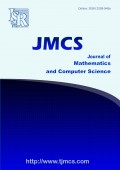On topological aspects of bilayer Germanium Phosphide
Volume 22, Issue 4, pp 347--362
http://dx.doi.org/10.22436/jmcs.022.04.04
Publication Date: September 05, 2020
Submission Date: February 12, 2020
Revision Date: June 03, 2020
Accteptance Date: June 15, 2020
-
1413
Downloads
-
2708
Views
Authors
Farukh Ejaz
- Department of Mathematics, COMSATS University Islamabad, Lahore Campus, Pakistan.
Muhammad Hussain
- Department of Mathematics, COMSATS University Islamabad, Lahore Campus, Pakistan.
Roslan Hasni
- School of Informatics and Applied Mathematics, Universiti Malaysia Terengganu, 21030 Kuala Terengganu, Malaysia.
Abstract
A material having electrical conductivity value falling between conductor and insulator is known as semiconductor.
Due to high adaptability of these materials makes them best basic material used in advanced electronics and communications.
Some popular semiconductors in periodic table are silicon, germanium and gallium arsenide. Here in this article we will give
topological aspects on different structural form of germanium phosphide. A semiconductor used in high frequency communication
and diodes.
Share and Cite
ISRP Style
Farukh Ejaz, Muhammad Hussain, Roslan Hasni, On topological aspects of bilayer Germanium Phosphide, Journal of Mathematics and Computer Science, 22 (2021), no. 4, 347--362
AMA Style
Ejaz Farukh, Hussain Muhammad, Hasni Roslan, On topological aspects of bilayer Germanium Phosphide. J Math Comput SCI-JM. (2021); 22(4):347--362
Chicago/Turabian Style
Ejaz, Farukh, Hussain, Muhammad, Hasni, Roslan. "On topological aspects of bilayer Germanium Phosphide." Journal of Mathematics and Computer Science, 22, no. 4 (2021): 347--362
Keywords
- Germanium Phosphide
- topological parameters
- degree invariants
MSC
References
-
[1]
H. Ali, H. M. A. Siddiqui, M. K. Shafiq, On Degree-Based Topological Descriptors of Oxide and Silicate Molecular Structures, MAGNT Res. Rep., 4 (2016), 135--142
-
[2]
A. Q. Baig, M. Imran, H. Ali, On topological indices of poly oxide, poly silicate, DOX, and DSL networks, Canad. J. Chem., 93 (2015), 730--739
-
[3]
K. C. Das, I. Gutman, Some properties of the second Zagreb index, MATCH Commun. Math. Comput. Chem., 52 (2004), 103--112
-
[4]
W. Gao, W. F. Wang, The fifth geometric-arithmetic index of bridge graph and carbon nanocones, J. Difference Equ. Appl., 23 (2017), 100--109
-
[5]
I. Gutman, Degree-based topological indices, Croatica Chemica Acta, 86 (2013), 351--361
-
[6]
Y. Jing, Y. Ma, Y. Li, T. Heine, GeP3: A small indirect band gap 2D crystal with high carrier mobility and strong interlayer quantum confinement, Nano Letters, 17 (2017), 1833--1838
-
[7]
D. Kim, K. Zhang, J. M. Lim, G. H. Lee, K. Cho, M. Cho, Y. M. Kang, GeP3 with soft and tunable bonding nature enabling highly reversible alloying with Na ions, Materials Today Energy, 9 (2018), 126--136
-
[8]
B. Rajan, A. William, C. Grigorious, S. Stephen, On certain topological indices of silicate, honeycomb and hexagonal networks, J. Comput. Math. Sci., 3 (2012), 530--535
-
[9]
F. Simonraj, A. George, Topological properties of few poly oxide, poly silicate, DOX and DSL networks, Int. J. Future Comput. Commun., 2 (2013), 90--95
-
[10]
D. Vukičević, B. Furtula, Topological index based on the ratios of geometrical and arithmetical means of end-vertex degrees of edges, J. Math. Chem., 46 (2009), 1369--1376
-
[11]
B. Zeng, M. Long, X. Zhang, Y. Dong, M. Li, Y. Yi, H. Duan, Strain engineering on electronic structure and carrier mobility in monolayer GeP3, J. Phys. D: Appl. Phys., 51 (2018), 13 pages
-
[12]
C. M. Zhang, Y. Jiao, T. He, F. Ma, L. Kou, T. Liao, S. Bottle, A. Du, Two-dimensional GeP 3 as a high capacity electrode material for Li-ion batteries, Phys. Chem. Chem. Phys., 19 (2017), 25886--25890
-
[13]
B. Zhou, N. Trinajstić, On a novel connectivity index, J. Math. Chem., 46 (2009), 1252--1270

